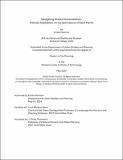Navigating Shared Vulnerabilities: Climate Adaptation on the Split Island of Saint Martin
Author(s)
Flamme, Emilie
DownloadThesis PDF (4.942Mb)
Advisor
Spirn, Anne Whiston
Terms of use
Metadata
Show full item recordAbstract
The island of Saint Martin on the windward side of the Caribbean Sea is a volcanic island whose low-lying areas are at high risk for flooding and storm surges as a result of exposure to increasing severe hurricanes that is compounded by sea level rise. Saint Martin’s mountainous landscape is split by two governments. The first is the Collectivity of Saint-Martin, a semi-autonomous region of France. The second is the Government of Sint Maarten, an independent island government within the Kingdom of the Netherlands. This thesis examines how both governments on the island of Saint Martin are working to develop climate adaptation strategies within a context of already existing chronic exposure to extreme climate risks. Given the administrative split and the severity of climate change, how can an island with two governments and two different approaches to climate change adapt to common future climate changes?
The work first traces how the construction of climate adaptation expertise is shaped by perceptual biases which originate from outside the Caribbean region, often in countries like the Netherlands and France. From this engagement on the construction of expertise, the Chapter 1 traces how hurricanes have shaped how climate and weather events are understood and confronted by islanders and argues that future hurricane models articulate changes to everyday climate conditions that stand to challenge longstanding practices of resilience in the face of extreme climate events. Chapter 2 examines current climate adaptation strategies implemented in the Collectivity of Saint-Martin, and underscores the relationship between risk perception, policy formulation, and historical context by highlighting the need for locally-adapted strategies. Chapter 3 examines how the Government of Sint Maarten attempts to address climate change and climate adaptation and considers avenues for community-centered risk assessment and adaptation planning. Chapter 4 engages the limitations of both strategies in Saint-Martin and Sint Maarten, and proposes an alternative vision for climate adaptation given the shared vulnerabilities that exist for both sides of Saint Martin.
Date issued
2024-05Department
Massachusetts Institute of Technology. Department of Urban Studies and PlanningPublisher
Massachusetts Institute of Technology